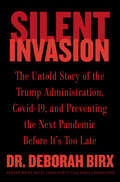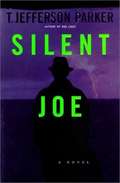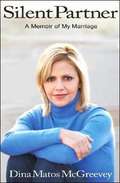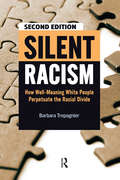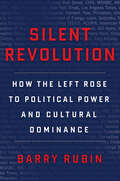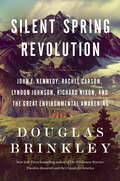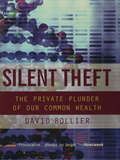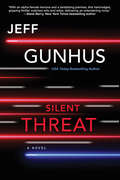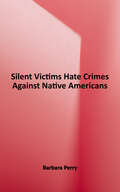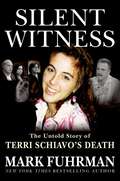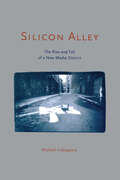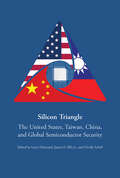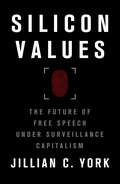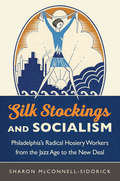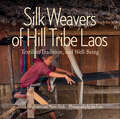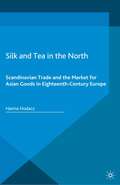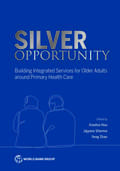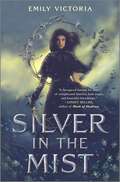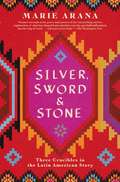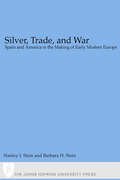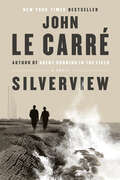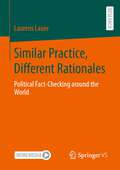- Table View
- List View
Silent Invasion: The Untold Story of the Trump Administration, Covid-19, and Preventing the Next Pandemic Before It's Too Late
by Deborah BirxThe definitive, inside account of the Trump Administration’s response to the Covid-19 pandemic from White House Coronavirus Response Coordinator and Coronavirus Task Force member, Dr. Deborah Birx.In late February 2020, Dr. Deborah Birx—a lifelong federal health official who had worked at the CDC, the State Department, and the US Army across multiple presidential administrations—was asked to join the Trump White House Coronavirus Task Force and assist the already faltering federal response to the Covid-19 pandemic. For weeks, she’d been raising the alarm behind the scenes about what she saw happening in public—from the apparent lack of urgency at the White House to the routine downplaying of the risks to Americans. Once in the White House, she was tasked with helping fix the broken federal approach and making President Trump see the danger this virus posed to all of us.Silent Invasion is the story of what she witnessed and lived for the next year—an eye-opening, inside account, detailed here for the first time, of the Trump Administration’s response to the greatest public health crisis in modern times. Regarded with suspicion in the West Wing from day one, Dr. Birx goes beyond the media speculation and political maneuvering to show what she was really up against in the Trump White House. Digging into the hard-fought victories, the costly mistakes, and the human drama surrounding the administration’s efforts, she examines the forces that crippled efforts to control the virus and explores why these blunders continue to haunt us today.And yet amid the agonizing missteps were bright spots that point the way forward—the fastest vaccine creation in history, governors that put their citizens’ health first, and Tribal Nations that demonstrated the powerful role of community in curbing spread, despite their criminally underfunded healthcare systems. Collectively these successes reveal the valiant work of many who were committed to saving lives, as well as highlighting the dire need to reform our public health institutions, so they are nimble and resilient enough to confront the next pandemic.With the pandemic now moving into its third year confounding two presidential administrations, Dr. Birx presents a story at once urgent and frustratingly unfinished, as Covid-19 continues to put thousands of American lives at risk. The end result is the most comprehensive and extensive accounting to date of the Trump Administration’s struggle to control the biggest health crisis in generations—a revelatory look at how we can learn from our mistakes and prevent this from happening again.
Silent Joe (First Edition)
by T. Jefferson ParkerJoe Trona is scarred in more ways than one. Rescued from an orphanage by Will Trona, a charismatic politician who sensed his dark potential, Joe is swept into the maelstrom of influence and intimidation that surrounds his adoptive father's career.
Silent No More: How I Became a Political Prisoner of Mueller’s “Witch Hunt”
by Jerome R. CorsiA Simon & Schuster eBook. Simon & Schuster has a great book for every reader.
Silent Partner: A Memoir of My Marriage
by Dina Matos McGreeveyThe truth behind the lies.It was an unforgettable scene. Dina Matos McGreevey, an attractive woman in her mid-thirties, wife, mother, and First Lady of the state of New Jersey, watched silently as her husband, then New Jersey Governor Jim McGreevey, resigned his office with the revelation that he was a "gay American." The picture of grace and loyalty, perfectly composed in her pale blue suit, Dina Matos McGreevey gave no sign of the tangled mixture of fear, sorrow, and anger she felt that day, no hint of the devastation that was to come. Since then she has been asked repeatedly about the nature of her marriage, about what she knew and when she knew it. Since then, she has remained silent. Until now.Speaking up at last, Dina Matos McGreevey here recounts the details of her marriage to Jim McGreevey. What emerges is a tale of love and betrayal, of heartbreak and scandal . . . and, ultimately, hope.It all began with so much promise. Dina Matos was a responsible and civic-minded young woman who fell in love with the passion of political action. When Jim McGreevey walked into her life, he appeared to be a kind and loving man, someone with whom she could build a life based on shared ideals, a strong spiritual commitment, and a desire to make a difference in the world. Beyond their initial chemistry, Dina Matos was attracted by Jim McGreevey's principles and his unwavering devotion to his work. She didn't know that his life, and thus their marriage, were built on a foundation of lies; that his past was littered with casual sexual encounters in seedy bookstores and public parks; or that, by his own admission, he began an adulterous affair with another man while she was in the hospital awaiting the birth of their child. "Could I have known," she asks. "How could I have known?"With scalding honesty, she tells of her life with the former governor, of the politics and public service that brought them together, and the lies that tore them apart.Here is a story of a marriage that was anything but happily-ever-after, told by a strong and resilient woman who can, and finally will, speak for herself.
Silent Racism: How Well-Meaning White People Perpetuate the Racial Divide
by Barbara TrepagnierVivid and engaging, Silent Racism persuasively demonstrates that silent racism—racism by people who classify themselves as “not racist”—is instrumental in the production of institutional racism. Trepagnier argues that heightened race awareness is more important in changing racial inequality than judging whether individuals are racist. The collective voices and confessions of “nonracist” white women heard in this book help reveal that all individuals harbor some racist thoughts and feelings. Trepagnier uses vivid focus group interviews to argue that the oppositional categories of racist/not racist are outdated. The oppositional categories should be replaced in contemporary thought with a continuum model that more accurately portrays today’s racial reality in the United States. A shift to a continuum model can raise the race awareness of well-meaning white people and improve race relations. Offering a fresh approach, Silent Racism is an essential resource for teaching and thinking about racism in the twenty-first century.
Silent Revolution: How the Left Rose to Political Power and Cultural Dominance
by Barry RubinA respected historian and political scientist charts the unchecked rise to power of radical leftism.Over the past fifty years, a silent revolution has allowed the radical left to seize power to an extent unthinkable only a decade ago. Stranger still, no one has noticed.Throughout the twentieth century, leftists worked tirelessly toward their goal of a proletarian revolution. But they continually fell short. American workers rejected socialism in the 1920s and declined to join the international communist movement in the 1930s. The New Left flowered briefly in the 1960s but petered out with the end of the Vietnam War. When the Soviet Union finally collapsed in 1991, radical Marxism seemed to have been defeated and discredited for good.Not so fast, says the political scientist Barry Rubin in this sharply pointed history of the modern American left. Far from disappearing, the radical left has undergone an ideological revolution and has rebranded itself as liberalism. Rubin traces the roots of this new ideology to the ideas of domestic radicals like Saul Alinsky, cultural Marxists like Antonio Gramsci, and Third World revolutionary thinkers like Frantz Fanon. This new brand of leftism constitutes a Third Left that now dominates the liberal movement in the United States.The Third Left’s main ideological innovation is the abandonment of the working class as a revolutionary vehicle. Instead it targets the education system, and it has now trained several generations of Americans to think in leftist terms of fairness and social justice. Imbued with this new “common sense,” these young people have fanned out through the professions, the government, and the media, where they unhesitatingly advance the ideas and goals of the left: anticapitalism, a state-controlled medical system, the semi-nationalization of key industries, the redistribution of wealth, and a rejection of America’s leading role in the world. As a result, without any real debate or understanding, the citizens of the United States have elected the most radical left-wing government in the country’s history.Silent Revolution offers a brief, readable, and utterly devastating critique of the radicalism that masquerades as liberalism today.
Silent Spring Revolution: John F. Kennedy, Rachel Carson, Lyndon Johnson, Richard Nixon, and the Great Environmental Awakening
by Douglas BrinkleyNew York Times bestselling author and acclaimed presidential historian Douglas Brinkley chronicles the rise of environmental activism during the Long Sixties (1960-1973), telling the story of an indomitable generation that saved the natural world under the leadership of John F. Kennedy, Lyndon Johnson, and Richard Nixon.With the detonation of the Trinity explosion in the New Mexico desert in 1945, the United States took control of Earth’s destiny for the first time. After the Truman administration dropped atomic bombs on Japan to end World War II, a grim new epoch had arrived. During the early Cold War years, the federal government routinely detonated nuclear devices in the Nevada desert and the Marshall Islands. Not only was nuclear fallout a public health menace, but entire ecosystems were contaminated with radioactive materials. During the 1950s, an unprecedented postwar economic boom took hold, with America becoming the world’s leading hyperindustrial and military giant. But with this historic prosperity came a heavy cost: oceans began to die, wilderness vanished, the insecticide DDT poisoned ecosystems, wildlife perished, and chronic smog blighted major cities. In Silent Spring Revolution, Douglas Brinkley pays tribute to those who combated the mauling of the natural world in the Long Sixties: Rachel Carson (a marine biologist and author), David Brower (director of the Sierra Club), Barry Commoner (an environmental justice advocate), Coretta Scott King (an antinuclear activist), Stewart Udall (the secretary of the interior), William O. Douglas (Supreme Court justice), Cesar Chavez (a labor organizer), and other crusaders are profiled with verve and insight. Carson’s book Silent Spring, published in 1962, depicted how detrimental DDT was to living creatures. The exposé launched an ecological revolution that inspired such landmark legislation as the Wilderness Act (1964), the Clean Air Acts (1963 and 1970), and the Endangered Species Acts (1966, 1969, and 1973). In intimate detail, Brinkley extrapolates on such epic events as the Donora (Pennsylvania) smog incident, JFK’s Limited Nuclear Test Ban Treaty, Great Lakes preservation, the Santa Barbara oil spill, and the first Earth Day.With the United States grappling with climate change and resource exhaustion, Douglas Brinkley’s meticulously researched and deftly written Silent Spring Revolution reminds us that a new generation of twenty-first-century environmentalists can save the planet from ruin.Silent Spring Revolution features two 8-page color photo inserts.
Silent Theft: The Private Plunder of Our Common Wealth
by David Bollier'They hang the man and flog the woman That steal the goose from off the common, But let the greater villain loose That steals the common from the goose.' - Traditional nursery rhyme Until a 1998 federal court decision, a Minnesota publisher claimed to own every federal court decision, including Roe v. Wade and Brown v. Board of Education. A Texas c
Silent Threat
by Jeff Gunhus&“Super-high stakes, super-high concept, and super-charged action. This propulsive spy thriller changes all the rules—it will have you holding your breath until you discover the final shocking truth. Jeff Gunhus is a terrific talent.&” —Hank Phillippi Ryan, national bestselling author of The Murder List A father charged with treason. A daughter sent to kill him. A shocking conspiracy that changes all the rules of the spy game for a new generation . . . With more than a dozen kills under her belt, ex-Marine Mara Roberts is one of the Agency&’s most reliable assassins. But her latest target—a convicted traitor about to be released from prison—is different than her other marks. He&’s a former agent who betrayed his country. He&’s responsible for the death of Mara&’s mother. And he happens to be Mara&’s father . . . Scott Roberts knows that his daughter was sent to kill him. He realizes he has only one chance to change her mind, to convince her that he&’s been framed for treason—and that every member of their family are pawns to be sacrificed, one by one. Mara isn&’t sure she can trust her father. He is a master of manipulation, as ruthless as he is resourceful. But when her nephew is abducted, she agrees to follow Scott&’s lead and expose the global elites who are pulling the strings. But first, they must infiltrate the highest levels of power. Then, they must attempt the unthinkable: Kidnap the President of the United States . . . &“A brilliantly written thriller. Breakneck twists, political intrigue and bristling action scenes—Jeff Gunhus writes with a gripping and gritty authority.&”—Simon Gervais, author of Hunt Them Down
Silent Victims: Hate Crimes Against Native Americans
by Barbara PerryHate crimes against Native Americans are a common occurrence, Barbara Perry reveals, although most go unreported. In this eye-opening book, Perry shines a spotlight on these acts, which are often hidden in the shadows of crime reports. She argues that scholarly and public attention to the historical and contemporary victimization of Native Americans as tribes or nations has blinded both scholars and citizens alike to the victimization of individual Native Americans. It is these acts against individuals that capture her attention. <p><p> Silent Victims is a unique contribution to the literature on hate crime. Because most extant literature treats hate crimes—even racial violence—rather generically, this work breaks new ground with its findings. For this book, Perry interviewed nearly 300 Native Americans and gathered additional data in three geographic areas: the Four Corners region of the U.S. Southwest, the Great Lakes, and the Northern Plains. In all of these locales, she found that bias-related crime oppresses and segregates Native Americans. <p><p> Perry is well aware of the history of colonization in North America and its attendant racial violence. She argues that the legacy of violence today can be traced directly to the genocidal practices of early settlers, and she adds valuable insights into the ways in which “Indians” have been constructed as the Other by the prevailing culture. Perry’s interviews with Native Americans recount instances of appalling treatment, often at the hands of law enforcement officials. In her conclusion, Perry draws from her research and interviews to suggest ways in which Native Americans can be empowered to defend themselves against all forms of racist victimization.
Silent Witness: The Untold Story of Terri Schiavo's Death
by Mark FuhrmanWe all watched Terri Schiavo die. The controversy around her case dominated the headlines and talk shows, going all the way to the U.S. Supreme Court, the White House, and the Vatican.And it's not over yet. Despite her death, the controversy lingers. In Silent Witness, former LAPD detective and New York Times bestselling author Mark Fuhrman applies his highly respected investigative skills to examine the medical evidence, legal case files, and police records. With the complete cooperation of Terri Schiavo's parents and siblings, as well as their medical and legal advisers, he conducts exclusive interviews with forensics experts and crucial witnesses, including friends, family members, and caregivers.Fuhrman's findings will answer these questions:What was Terri and Michael Schiavo's marriage really like?What happened the day Terri collapsed?What did Michael Schiavo do when he discovered Terri unconscious? How long did he wait before calling 911?What do medical records show about her condition when she was first admitted to the hospital?What will the autopsy say?The legal issues and ethical questions provoked by Terri Schiavo's extraordinary case may never be resolved. But the facts about her marriage, her condition when she collapsed, and her eventual death fifteen years later can be determined.With Silent Witness, Fuhrman goes beyond the legal aspects of the case and delves into the broader, human background of Terri Schiavo's short, sad life.
Silicon Alley: The Rise and Fall of a New Media District (Cultural Spaces)
by Michael IndergaardThe 1990s dawned with a belief that the digital revolution would radically transform our traditional notion of cities as places of commerce and industry. Many predicted that digital technology would render cities--or at least their economies--obsolete. Instead, precisely the opposite happened. The IT-intensive firms of the new economy needed to be plugged into a sizeable network of talent, something that established cities like New York and San Francisco provided in abundance. In addition to creating new types of jobs and luring thousands of workers back into the city, new media districts created a new technobohemian urban culture. With vignettes of the high-rollers in New York's new media economy and stories of wild parties in downtown lofts, Michael Indergaard introduces us to the players in this new economy, and explores this intersection of commerce and culture in 1990s New York. He also reveals how the dot-com crash laid bare the hidden connections between the so-called new economy of new media, and the ages old engines of New York wealth: real estate speculators and Wall Street. Chronicling the go-go years and ultimate crash of the new media district, Silicon Alley is a brilliant account of how hype forged a marriage of technology and finance, which in turn generated a new urban culture.
Silicon Triangle: The United States, Taiwan, China, and Global Semiconductor Security
by Larry Diamond Orville Schell James O. Ellis Jr.The United States, Taiwan, and China are bound within a "silicon triangle." Semiconductors link our geopolitics, our ongoing economic prosperity, and our technological competitiveness. This book draws on the deliberations of a multidisciplinary Hoover Institution–Asia Society working group of technologists, economists, military strategists, industry players, and regional policy experts to contemplate the dynamic global supply chain in semiconductors—one in which US industry faces growing vulnerabilities, China aggressively promotes home-grown semiconductor mastery, and Taiwan finds itself with a crucial monopoly on high-end logic chips sought by buyers globally. Silicon Triangle seeks to present a balanced view of how policies of the United States and its partners around semiconductors can increase the resilience of shared supply chains—and contribute to deterring conflict in the Taiwan Strait.
Silicon Values: The Future of Free Speech Under Surveillance Capitalism
by Jillian C. YorkHow Google, Facebook and Amazon threaten our DemocracyWhat is the impact of surveillance capitalism on our right to free speech? The Internet once promised to be a place of extraordinary freedom beyond the control of money or politics, but today corporations and platforms exercise more control over our ability to access information and share knowledge to a greater extent than any state. From the online calls to arms in the thick of the Arab Spring to the contemporary front line of misinformation, Jillian York charts the war over our digital rights. She looks at both how the big corporations have become unaccountable censors, and the devastating impact it has had on those who have been censored.In Silicon Values, leading campaigner Jillian York, looks at how our rights have become increasingly undermined by the major corporations desire to harvest our personal data and turn it into profit. She also looks at how governments have used the same technology to monitor citizens and threatened our ability to communicate. As a result our daily lives, and private thoughts, are being policed in an unprecedented manner. Who decides the difference between political debate and hate speech? How does this impact on our identity, our ability to create communities and to protest? Who regulates the censors? In response to this threat to our democracy, York proposes a user-powered movement against the platforms that demands change and a new form of ownership over our own data.
Silk Stockings and Socialism: Philadelphia's Radical Hosiery Workers from the Jazz Age to the New Deal
by Sharon McConnell-SidorickThe 1920s Jazz Age is remembered for flappers and speakeasies, not for the success of a declining labor movement. A more complex story was unfolding among the young women and men in the hosiery mills of Kensington, the working-class heart of Philadelphia. Their product was silk stockings, the iconic fashion item of the flapper culture then sweeping America and the world. Although the young people who flooded into this booming industry were avid participants in Jazz Age culture, they also embraced a surprising, rights-based labor movement, headed by the socialist-led American Federation of Full-Fashioned Hosiery Workers (AFFFHW).In this first history of this remarkable union, Sharon McConnell-Sidorick reveals how activists ingeniously fused youth culture and radical politics to build a subculture that included dances and parties as well as picket lines and sit-down strikes, while forging a vision for social change. In documenting AFFFHW members and the Kensington community, McConnell-Sidorick shows how labor federations like the Congress of Industrial Organizations and government programs like the New Deal did not spring from the heads of union leaders or policy experts but were instead nurtured by grassroots social movements across America.
Silk Weavers of Hill Tribe Laos: Textiles, Tradition, and Well-Being
by Joshua Hirschstein Maren BeckWinner, Gold Medal in the Travel Category, 2018 IBPA Benjamin Franklin Awards Part travelogue, part silk-weaving primer, this is a tender portrait of an American family's travels in Laos's Houaphon Province. As they learn about the ancient silk weaving traditions in the hilltribe community of Xam Tai, they gain an appreciation for the strong sense of well-being in Lao culture. Over the past decade, Hirschstein and Beck have developed deep connections with the villagers of Xam Tai who raise their own fiber from silkworms, dye it using local natural dyes, and weave the patterns of their ancestors into healing cloths, ceremonial textiles, and daily wear.
Silk and Insight: A Novel
by Yukio Mishima Frank Gibney Hiro SatoThis is a tale based on the strike which took place in the mid-1950s at Omi Kenshi, a silk manufacturer not far from Tokyo. The events described reflect the management / labour tensions of the period and is a piece of social commentary on the transformation of Japanese business.
Silk and Tea in the North: Scandinavian Trade and the Market for Asian Goods in Eighteenth-Century Europe (Europe's Asian Centuries)
by Hanna HodacsThis book links the trade of the Danish and Swedish East India companies to the British taste for tea, a Scandinavian craving for colourful Chinese silk textiles, import substitutions schemes and natural history in the eighteenth century. It is a global history exploring the exchange of silver for goods in Canton. It is also a European history studying the wholesale market for Asian goods in Gothenburg and Copenhagen, the formation of taste and the impact of fashion in the blending of tea and the assortments of colours on wrought silk destined for markets across Europe. Linking material history to political economy and the histories of science, this book ends on the threshold of the nineteenth century, the rise of the second British Empire in Asia, and the creation of synthetic dyes in Europe.
Silver Opportunity Case Studies: Experiences with Building Integrated Services for Older Adults around Primary Health Care
by Feng Zhao Xiaohui Hou Jigyasa SharmaHealth care systems must be prepared to address the expanding and complex needs of an aging population. Rather than a 'silver challenge,' this situation should be seen as an opportunity to reevaluate and reorganize the health care delivery system holistically. Silver Opportunity Case Studies presents a comprehensive examination of care for older adults in diverse economic and geographic contexts through a collection of country and regional case studies. This collection of case studies complements the synthesis volume of global evidence--Silver Opportunity: Building Integrated Services for Older Adults around Primary Health Care--by offering practical insights for decision-making, sharing knowledge, and encouraging cross-learning. The book provides a deeper understanding of the complexities involved and highlights key issues and current practices at the country level. The overarching goal of the volume is to inform policy makers, health care professionals, and other stakeholders about effective practices for caring for older adults and to support the development of evidence-based policies that enhance their health and well-being.d well-being.
Silver Opportunity: Building Integrated Services for Older Adults around Primary Health Care
by Feng Zhao Xiaohui Hou Jigyasa SharmaWe live in a rapidly aging world, in which people who are age 60 and older outnumber children under the age of five. This book reveals large and growing gaps in care for older adults in countries at all income levels and shows how to leverage reforms for improving health outcomes for older adults and create healthier, more prosperous communities. Aimed at policy makers and other health and development stakeholders who want to promote healthier aging, Silver Opportunity compiles the latest evidence on care needs and gaps for aging populations. It argues that primary health care should be the cornerstone of integrated service delivery for older people, but primary health care systems must first build their capacity to respond to older people’s health needs. It presents an original framework for policy action to advance primary health care†“centered, integrated senior care; documents the experiences of pioneering countries in delivering community-based care to older people; and provides recommendations for decision-makers. The framework presents four policy levers with which to improve health care for seniors--financing, innovation, regulation, and evaluation and measurement--or FIRE. Finally, the book posits that by acting now, countries can leverage population aging to accelerate progress toward health equity and universal health coverage.
Silver in the Mist
by Emily VictoriaEight years ago, everything changed for Devlin: Her country was attacked. Her father was killed. And her mother became the Whisperer of Aris, the head of the spies, retreating into her position away from everyone… even her daughter. Joining the spy ranks herself, Dev sees her mother only when receiving assignments. She wants more, but she understands the peril their country, Aris, is in. The malevolent magic force of The Mists is swallowing Aris&’s edges, their country is vulnerable to another attack from their wealthier neighbor, and the magic casters who protect them from both are burning out.Dev has known strength and survival her whole life, but with a dangerous new assignment of infiltrating the royal court of their neighbor country Cerena to steal the magic they need, she learns that not all that glitters is weak. And not all stories are true.
Silver, Sword, and Stone: Three Crucibles in the Latin American Story
by Marie AranaWinner, American Library Association Booklist&’s Top of the List, 2019 Adult Nonfiction Longlisted for the 2020 Andrew Carnegie Medals for Excellence Against the background of a thousand years of vivid history, acclaimed writer Marie Arana tells the timely and timeless stories of three contemporary Latin Americans whose lives represent three driving forces that have shaped the character of the region: exploitation (silver), violence (sword), and religion (stone).Leonor Gonzales lives in a tiny community perched 18,000 feet above sea level in the Andean cordillera of Peru, the highest human habitation on earth. Like her late husband, she works the gold mines much as the Indians were forced to do at the time of the Spanish Conquest. Illiteracy, malnutrition, and disease reign as they did five hundred years ago. And now, just as then, a miner&’s survival depends on a vast global market whose fluctuations are controlled in faraway places. Carlos Buergos is a Cuban who fought in the civil war in Angola and now lives in a quiet community outside New Orleans. He was among hundreds of criminals Cuba expelled to the US in 1980. His story echoes the violence that has coursed through the Americas since before Columbus to the crushing savagery of the Spanish Conquest, and from 19th- and 20th-century wars and revolutions to the military crackdowns that convulse Latin America to this day. Xavier Albó is a Jesuit priest from Barcelona who emigrated to Bolivia, where he works among the indigenous people. He considers himself an Indian in head and heart and, for this, is well known in his adopted country. Although his aim is to learn rather than proselytize, he is an inheritor of a checkered past, where priests marched alongside conquistadors, converting the natives to Christianity, often forcibly, in the effort to win the New World. Ever since, the Catholic Church has played a central role in the political life of Latin America—sometimes for good, sometimes not. In Silver, Sword, and Stone Marie Arana seamlessly weaves these stories with the history of the past millennium to explain three enduring themes that have defined Latin America since pre-Columbian times: the foreign greed for its mineral riches, an ingrained propensity to violence, and the abiding power of religion. What emerges is a vibrant portrait of a people whose lives are increasingly intertwined with our own.
Silver, Trade, and War: Spain and America in the Making of Early Modern Europe
by Stanley J. Stein Barbara H. SteinA look at the interaction of America, Spain, and Europe between 1500 and 1750, focusing on Spain’s role in Europe’s expansion across the Atlantic.The 250 years covered by this book marked the era of commercial capitalism, bridging late medieval and modern times. In 1500, Spain brought American silver back home across the Atlantic in exchange for European goods. Spanish colonialism, the authors suggest, was the cutting edge of the early global economy. America’s silver enabled Spain to bring elements of capitalism into its late medieval society. However, the authors argue, silver gave Spain illusions of wealth, security, and dominance, while its system of “managed” transatlantic trade failed to monitor silver flows that were beyond government control. While Spain’s intervention reinforced Hapsburg efforts at hegemony in Europe, it also led to proto-nationalist state formations, notably in England and France. 1714’s Treaty of Utrecht emphasized the lag between developing England and France, and stagnating Spain, and the persistence of Spain’s late medieval structures. These were basic elements of what the authors term Spain’s Hapsburg “legacy.”Over the first half of the eighteenth century, Spain under the Bourbons tried to contain expansionist France and England in the Caribbean and to create policies competitors seemed to apply successfully to their overseas possessions, namely, a colonial compact. Spain’s policy planners (proyectistas) scanned abroad for models of modernization adaptable to Spain and its American colonies without risking institutional change. The second part of the book analyzes the projectors’ works and their minimal impact on the changing Atlantic scene until 1759. By then, despite its efforts, Spain could no longer compete with England and France in the international economy. Silver, Trade, and War is about markets, national rivalries, diplomacy, conflict, and the advancement or stagnation of states.
Silverview: A Novel
by John Le CarréIn Silverview, John le Carré turns his focus to the world that occupied his writing for the past sixty years—the secret world itself. Julian Lawndsley has renounced his high-flying job in the City for a simpler life running a bookshop in a small English seaside town. But only a couple of months into his new career, Julian’s evening is disrupted by a visitor. <p><p> Edward, a Polish émigré living in Silverview, the big house on the edge of town, seems to know a lot about Julian’s family and is rather too interested in the inner workings of his modest new enterprise. When a letter turns up at the door of a spy chief in London warning him of a dangerous leak, the investigations lead him to this quiet town by the sea . . . Silverview is the mesmerizing story of an encounter between innocence and experience and between public duty and private morals. In this last complete masterwork from the greatest chronicler of our age, John le Carré asks what you owe to your country when you no longer recognize it.
Similar Practice, Different Rationales: Political Fact-Checking around the World
by Laurens LauerMisinformation and disinformation have emerged as paramount societal challenges, affecting areas from public health to climate change and eroding both social understanding and democratic values. Enter the political fact-checkers: stalwart defenders of accurate public information and guardians of robust public discourse. What began as an endeavor to verify political claims in the U.S. has transformed into a global movement addressing diverse forms of public information, harnessing innovative tech tools, championing media literacy, and exploring governance solutions. Who are these fact-checkers, and how have they become such a versatile force against misinformation? While united by very similar verification practices, the community of fact-checkers is remarkably diverse. Reflecting the media-political landscapes they navigate, these initiatives bring together a spectrum of professional expertise, visions, and strategies. This book delves into this fascinating world, exploring how the concept of fact-checking has proliferated globally. Spotlighting efforts in Argentina, Georgia, Italy, and the U.S., it offers an in-depth understanding of fact-checkers' approaches, their alignment with distinct environments, and their potential impact on modern public discourse.
